The Differences in the Flavan-3-ol and Procyanidin Contents of the Japanese ‘Fuji’ and ‘Orin’ Apples Using a Rapid Quantitative High-Performance Liquid Chromatography Method: Estimation of the Japanese Intake of Flavan-3-ols and Procyanidins from Apple as Case Study
Abstract
1. Introduction
2. Materials and Methods
2.1. Chemicals
2.2. Isolation of Individual Oligomer Standards from Apple Extract by Preparative High-Performance Liquid Chromatography (HPLC)
2.3. Apples (Sampling and Storage)
2.4. Sample Preparations
2.5. Extractions of the Flavan-3-ols and Procyanidins
2.6. Analysis of the Flavan-3-ols and Procyanidins by a Rapid HPLC with Fluorescence Detection
2.6.1. Chromatographic Conditions
2.6.2. Preparation of Standard Solutions
2.6.3. Calibration Carves
2.6.4. Method Validation
Selectivity
Limits of Detection (LOD) and Limit of Quantification (LOQ)
Method Precision
Method Trueness
2.7. Quantification of the Flavan-3-ols and Procyanidins in Apples
2.8. Statistical Analysis
3. Results and Discussion
3.1. HPLC with Fluorescence Detection Was Used to Analyse the Flavan-3-ols and Procyanidins
3.1.1. Optimized Method for the Analysis of Flavan-3-ols and Procyanidins in Apples
3.1.2. Method Validations
Calibration Conditions
Method Precision
Method Trueness
3.2. Flavan-3-ol and Procyanidin Concentrations in the ‘Fuji’ Apples
3.3. Flavan-3-ol and Procyanidin Concentrations in the ‘Orin’ Apples
3.4. Differences in the Flavan-3-ols and Procyanidins in the Apple Peel
4. Conclusions
Supplementary Materials
Author Contributions
Funding
Institutional Review Board Statement
Informed Consent Statement
Data Availability Statement
Acknowledgments
Conflicts of Interest
References
- Bondonno, N.P.; Dalgaard, F.; Kyro, C.; Murray, K.; Bondonno, C.P.; Lewis, J.R.; Croft, K.D.; Gislason, G.; Scalbert, A.; Cassidy, A.; et al. Flavonoid Intake Is Associated with Lower Mortality in the Danish Diet Cancer and Health Cohort. Nat. Commun. 2019, 10, 3651. [Google Scholar] [CrossRef] [PubMed]
- Fraga, C.G.; Croft, K.D.; Kennedy, D.O.; Barberan, F.A.T. The Effects of Polyphenols and Other Bioactives on Human Health. Food Funct. 2019, 10, 514–528. [Google Scholar] [CrossRef] [PubMed]
- Knekt, P.; Kumpulainen, J.; Jarvinen, R.; Rissanen, H.; Heliovaara, M.; Reunanen, A.; Hakulinen, T.; Aromaa, A. Flavonoid Intake and Risk of Chronic Diseases. Am. J. Clin. Nutr. 2002, 76, 560–568. [Google Scholar] [CrossRef] [PubMed]
- Weichselbaum, E.; Wyness, L.; Stanner, S. Apple Polyphenols and Cardiovascular Disease—A Review of the Evidence. Nutr. Bull. 2010, 35, 92–101. [Google Scholar] [CrossRef]
- Briggs, A.D.M.; Mizdrak, A.; Scarborough, P. A Statin a Day Keeps the Doctor Away: Comparative Proverb Assessment Modelling Study. BMJ 2013, 347. [Google Scholar] [CrossRef]
- Kalinowska, M.; Bielawska, A.; Siwkiewicz, H.L.; Priebe, W.; Lewandowski, W. Apples: Content of Phenolic Compounds vs. Variety, Part of Apple and Cultivation Model, Extraction of Phenolic Compounds, Biological Properties. Plant Physiol. Biochem. 2014, 84, 169–188. [Google Scholar] [CrossRef]
- Vrhovsek, U.; Rigo, A.; Tonon, D.; Mattivi, F. Quantitation of Polyphenols in Different Apple Varieties. J. Agric. Food Chem. 2004, 52, 6532–6538. [Google Scholar] [CrossRef]
- Sugiyama, H.; Akazome, Y.; Shoji, T.; Yamaguchi, A.; Yasue, M.; Kanda, T.; Ohtake, Y. Oligomeric Procyanidins in Apple Polyphenol Are Main Active Components for Inhibition of Pancreatic Lipase and Triglyceride Absorption. J. Agric. Food Chem. 2007, 55, 4604–4609. [Google Scholar] [CrossRef]
- Lotito, S.B.; Actis-Goretta, L.; Renart, M.L.; Caligiuri, M.; Rein, D.; Schmitz, H.H.; Steinberg, F.M.; Keen, C.L.; Fraga, C.G. Influence of Oligomer Chain Length on the Antioxidant Activity of Procyanidins. Biochem. Biophys. Res. Commun. 2000, 276, 945–951. [Google Scholar] [CrossRef]
- Obara, M.; Masumoto, S.; Ono, Y.; Ozaki, Y.; Shoji, T. Procyanidin Concentrations and H-ORAC of Apples Cultivated in Japan. Food Sci. Technol. Res. 2016, 22, 563–568. [Google Scholar] [CrossRef]
- Michels, K.B.; Giovannucci, E.; Chan, A.T.; Singhania, R.; Fuchs, C.S.; Willett, W.C. Fruit and Vegetable Consumption and Colorectal Adenomas in the Nurses’ Health Study. Cancer Res. 2006, 66, 3942–3953. [Google Scholar] [CrossRef] [PubMed]
- Chai, S.C.; Hooshmand, S.; Saadat, R.L.; Payton, M.E.; Brummel-Smith, K.; Arjmandi, B.H. Daily Apple versus Dried Plum: Impact on Cardiovascular Disease Risk Factors in Postmenopausal Women. J. Acad. Nutr. Diet. 2012, 112, 1158–1168. [Google Scholar] [CrossRef] [PubMed]
- Choi, D.Y.; Lee, Y.J.; Hong, J.T.; Lee, H.J. Antioxidant Properties of Natural Polyphenols and Their Therapeutic Potentials For Alzheimer’s Disease. Brain. Res. Bull. 2012, 87, 144–153. [Google Scholar] [CrossRef] [PubMed]
- Shoji, T.; Yamada, M.; Miura, T.; Nagashima, K.; Ogura, K.; Inagaki, N.; Maeda-Yamamoto, M. Chronic Administration of Apple Polyphenols Ameliorates Hyperglycaemia in High-Normal and Borderline Subjects: A Randomised, Placebo-Controlled Trial. Diabetes Res. Clin. Pract. 2017, 129, 43–51. [Google Scholar] [CrossRef] [PubMed]
- Burda, S.; Oleszek, W.; Lee, C.Y. Phenolic Compounds and Their Changes in Apples during Maturation and Cold Storage. J. Agric. Food Chem. 1990, 38, 945–948. [Google Scholar]
- Mayr, U.; Treutter, D.; Santos-Buelga, C.; Bauer, H.; Feucht, W. Developmental Changes in the Phenol Concentrations of ’Golden Delicious’ Apple Fruits and Leaves. Phytochemistry 1995, 38, 1151–1155. [Google Scholar] [CrossRef]
- Tsao, R.; Yang, R.; Young, J.C.; Zhu, H. Polyphenolic Profiles in Eight Apple Cultivars Using High-Performance Liquid Chromatography (HPLC). J. Agric. Food Chem. 2003, 51, 6347–6353. [Google Scholar] [CrossRef]
- Huber, G.M.; Rupasinghe, H.P. Phenolic Profiles and Antioxidant Properties of Apple Skin Extracts. J. Food Sci. 2009, 74, C693–C700. [Google Scholar] [CrossRef]
- McGhie, T.K.; Hunt, M.; Barnett, L.E. Cultivar and Growing Region Determine the Antioxidant Polyphenolic Concentration and Composition of Apples Grown in New Zealand. J. Agric. Food Chem. 2005, 53, 3065–3070. [Google Scholar] [CrossRef]
- Golding, J.B.; McGlasson, W.B.; Wyllie, S.G.; Leach, D.N. Fate of Apple Peel Phenolics during Cool Storage. J. Agric. Food Chem. 2001, 49, 2283–2289. [Google Scholar] [CrossRef]
- Sluis, v.d.A.A.; Dekker, M.; de Jager, A.; Jongen, W.M. Activity and Concentration of Polyphenolic Antioxidants in Apple: Effect of Cultivar, Harvest Year, and Storage Conditions. J. Agric. Food Chem. 2001, 49, 3606–3613. [Google Scholar] [CrossRef] [PubMed]
- Awad, M.A.; de Jager, A. Influences of Air and Controlled Atmosphere Storage on the Concentration of Potentially Healthful Phenolics in Apples and Other Fruits. Postharvest Biol. Tec. 2003, 27, 53–58. [Google Scholar] [CrossRef]
- Leja, M.; Mareczek, A.; Ben, J. Antioxidant Properties of Two Apple Cultivars during Long-Term Storage. Food Chem. 2003, 80, 303–307. [Google Scholar] [CrossRef]
- Napolitano, A.; Cascone, A.; Graziani, G.; Ferracane, R.; Scalfi, L.; Di Vaio, C.; Ritieni, A.; Fogliano, V. Influence of Variety and Storage on the Polyphenol Composition of Apple Flesh. J. Agric. Food Chem. 2004, 52, 6526–6531. [Google Scholar] [CrossRef]
- Schofield, P.; Mbugua, D.M.; Pell, A.N. Analysis of Condensed Tannins: A Review. Anim. Feed Sci. Technol. 2001, 91, 21–40. [Google Scholar] [CrossRef]
- Robbins, R.J.; Leonczak, J.; Johnson, J.C.; Li, J.; Kwik-Uribe, C.; Prior, R.L.; Gu, L. Method Performance and Multi-Laboratory Assessment of a Normal Phase High Pressure Liquid Chromatography-Fluorescence Detection Method for the Quantitation of Flavanols and Procyanidins in Cocoa and Chocolate Containing Samples. J. Chromatogr. A 2009, 1216, 4831–4840. [Google Scholar] [CrossRef]
- Hollands, W.J.; Voorspoels, S.; Jacobs, G.; Aaby, K.; Meisland, A.; Villalba, R.G.; Barberan, F.T.; Piskula, M.K.; Mawson, D.; Vovk, I.; et al. Development, Validation and Evaluation of an Analytical Method for the Determination of Monomeric and Oligomeric Procya-Nidins in Apple Extracts. J. Chromatogr. A 2017, 1495, 46–56. [Google Scholar] [CrossRef]
- Shoji, T.; Masumoto, S.; Moriichi, N.; Kanda, T.; Ohtake, Y. Apple (Malus pumila) Procyanidins Fractionated According to the Degree of Polymerization Using Normal-Phase Chromatography and Characterized by HPLC-ESI/MS and MALDI-TOF/MS. J. Chromatogr. A 2006, 1102, 206–213. [Google Scholar] [CrossRef]
- Guyot, S.; Marnet, N.; Laraba, D.; Sanoner, P.; Drilleau, J.-F. Reversed-Phase HPLC following Thiolysis for Quantitative Estimation and Characterization of the Four Main Classes of Phenolic Compounds in Different Tissue Zones of a French Cider Apple Variety (Malus domestica Var. Kermerrien). J. Agric. Food Chem. 1998, 46, 1698–1705. [Google Scholar] [CrossRef]
- Gu, L.; Kelm, M.A.; Hammerstone, J.F.; Beecher, G.; Holden, J.; Haytowitz, D.; Gebhardt, S.; Prior, R.L. Concentrations of Proanthocyanidins in Common Foods and Estimations of Normal Consumption. J. Nutr. 2004, 134, 613–617. [Google Scholar] [CrossRef]
- Igarashi, M.; Hatsuyama, Y.; Harada, T.; Fukasawa-Akada, T. Biotechnology and Apple Breeding in Japan. Breed Sci. 2016, 66, 18–33. [Google Scholar] [CrossRef] [PubMed]
- Ritenour, M.A.; Ahrens, M.J.; Saltveit, M.E. Effects of Temperature on Ethylene-induced Phenylalanine Ammonia Lyase Activity and Russet Spotting in Harvested Iceberg Lettuce. J. Am. Soc. Hortic. Sci. 1995, 120, 84–87. [Google Scholar] [CrossRef]
- Wojdylo, A.; Oszmianski, J. Antioxidant Activity Modulated by Polyphenol Contents in Apple and Leaves during Fruit Development and Ripening. Antioxidants (Basel) 2020, 9, 567. [Google Scholar] [CrossRef] [PubMed]
- Chen, C.-S.; Zhang, D.; Wang, Y.-Q.; Li, P.-M.; Ma, F.-W. Effects of Fruit Bagging on the Contents of Phenolic Compounds in the Peel and Flesh of ‘Golden Delicious’, ‘Red Delicious’, and ‘Royal Gala’ Apples. Sci. Horticu. 2012, 142, 68–73. [Google Scholar] [CrossRef]
- Arakawa, O. Effect of Temperature on Anthocyanin Accumulation in Apple Fruit as Affected by Cultivar, Stage of Fruit Ripening and Bagging. J. Hortic. Sci. 1991, 66, 763–768. [Google Scholar] [CrossRef]
- Wolfe, K.; Wu, X.; Liu, R.H. Antioxidant Activity of Apple Peels. J. Agric. Food Chem. 2003, 51, 609–614. [Google Scholar] [CrossRef]
- Kuhnle, G.G.C. Nutrition Epidemiology of Flavan-3-Ols: The Known Unknowns. Mol. Asp. Med. 2018, 61, 2–11. [Google Scholar] [CrossRef]
- US Department of Agriculture. USDA Database for the Flavonoid Content of Selected Foods. Available online: https://www.ars.usda.gov/ARSUserFiles/80400525/Data/Flav/Flav_R03-1.pdf, (accessed on 18 August 2016).
- Rothwell, J.A.; Perez-Jimenez, J.; Neveu, V.; Medina-Remon, A.; M’Hiri, N.; Garcia-Lobato, P.; Manach, C.; Knox, C.; Eisner, R.; Wishart, D.S.; et al. Phenol-Explorer 3.0: A Major Update of the Phenol-Explorer Database to Incorporate Data on the Effects of Food Processing on Polyphenol Content. Database (Oxford) 2013, 2013, bat070. [Google Scholar] [CrossRef]
- Sampson, L.; Rimm, E.; Hollman, P.C.; de Vries, J.H.; Katan, M.B. Flavonol and Flavone Intakes in US Health Professionals. J. Am. Diet. Assoc. 2002, 102, 1414–1420. [Google Scholar] [CrossRef]
- Vogiatzoglou, A.; Mulligan, A.A.; Luben, R.N.; Lentjes, M.A.; Heiss, C.; Kelm, M.; Merx, M.W.; Spencer, J.P.; Schroeter, H.; Kuhnle, G.G. Assessment of the Dietary Intake of Total Flavan-3-Ols, Monomeric Flavan-3-Ols, Proanthocyanidins and Theaflavins in the European Union. Br. J. Nutr. 2014, 111, 1463–1473. [Google Scholar] [CrossRef]
- Ministry of Agriculture, Forestry and Fisheries of Japan. 2018 Japan Agriculture, Forestry and Fisheries Statistical Data. Available online: http://www.maff.go.jp/j/tokei/kouhyou/sakumotu/sakkyou_kazyu/index.html (accessed on 29 January 2021).
- Ministry of Agriculture, Forestry and Fisheries of Japan. 2018 Japan Food Supply and Demand Data. Available online: https://www.maff.go.jp/j/zyukyu/fbs (accessed on 29 January 2021).
- Maeda-Yamamoto, M. Development of Functional Agricultural Products and Use of a New Health Claim System in Japan. Trends Food Sci. Technol. 2017, 69, 324–332. [Google Scholar] [CrossRef]
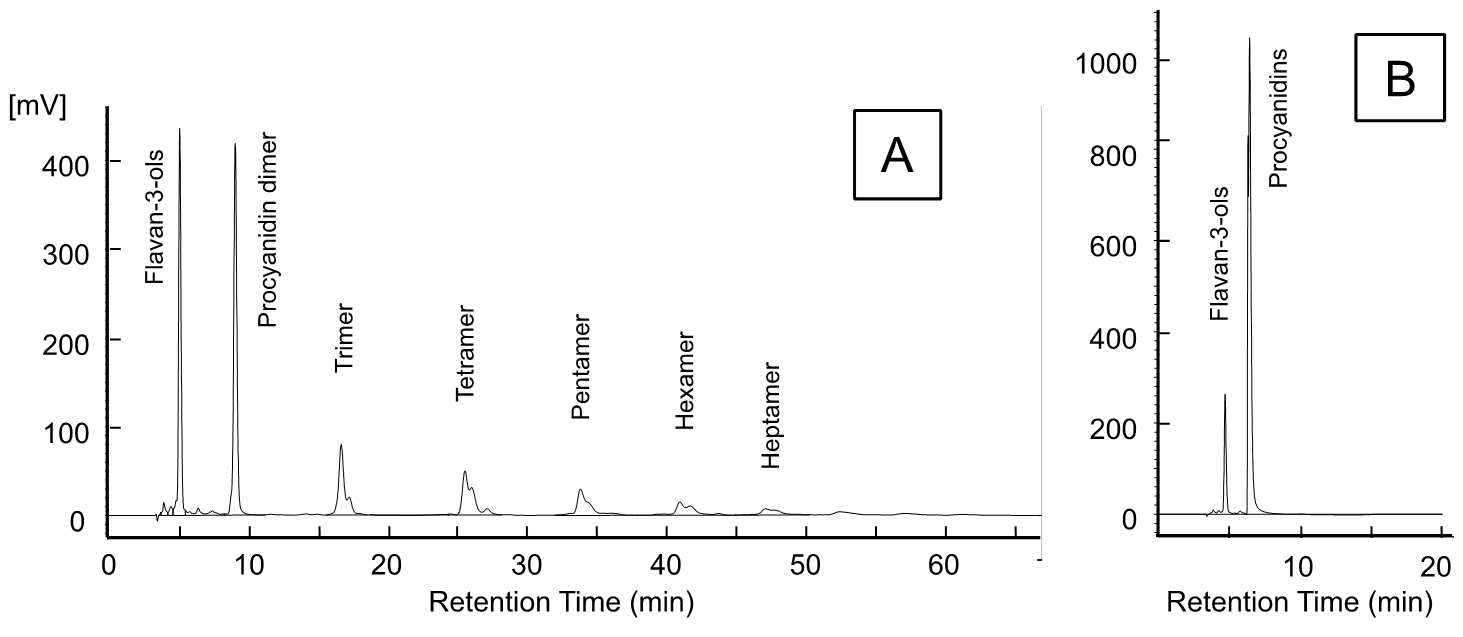
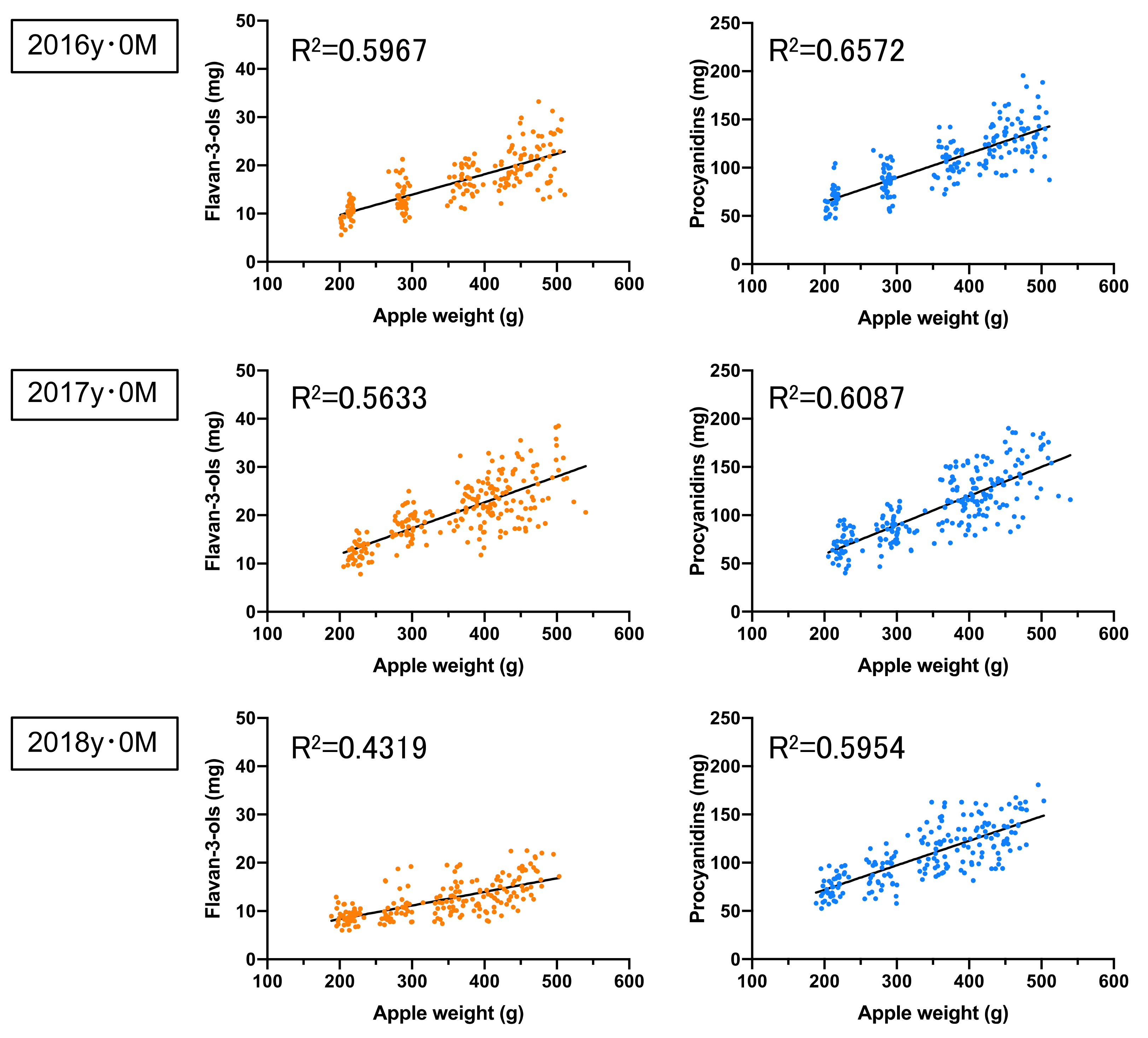
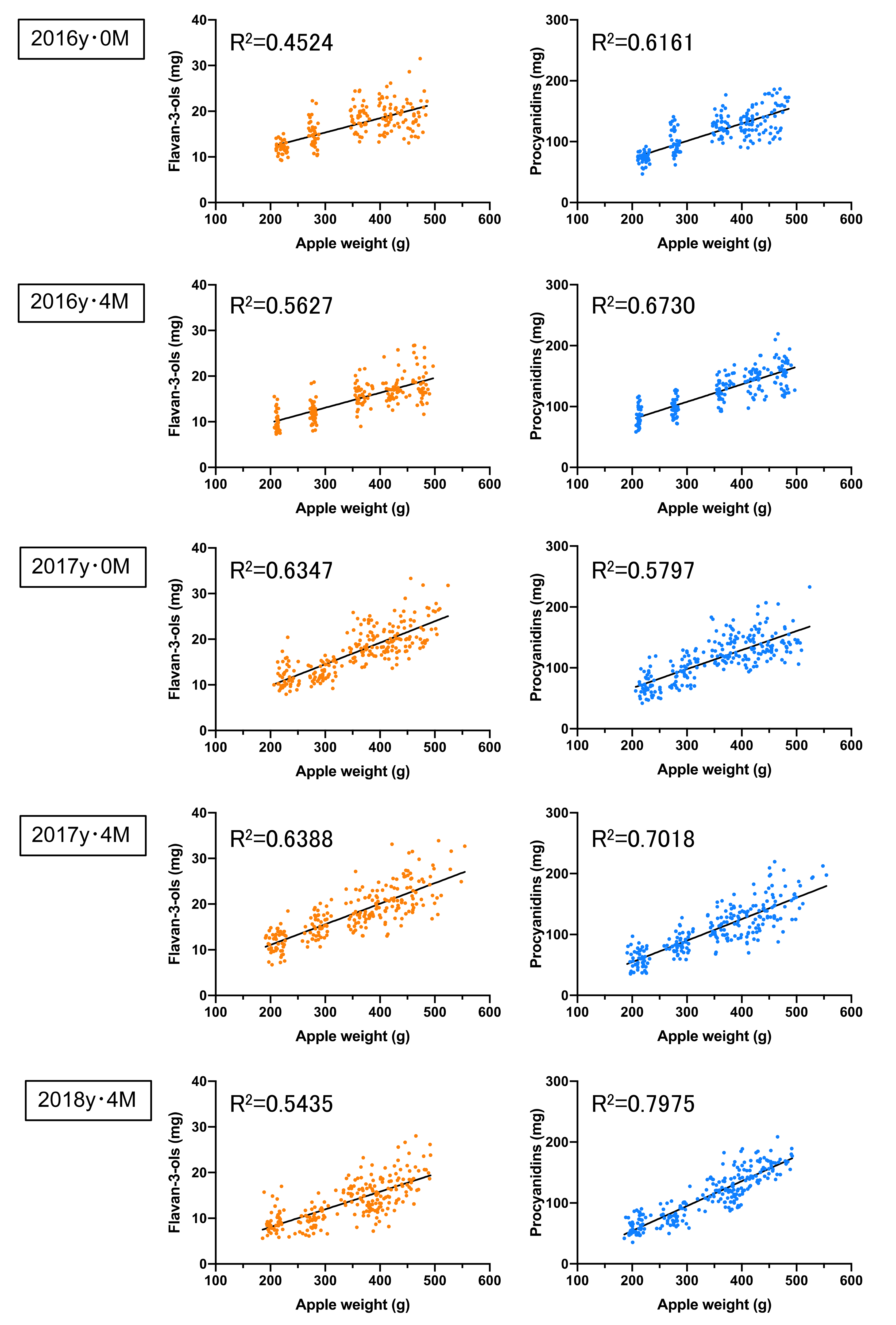
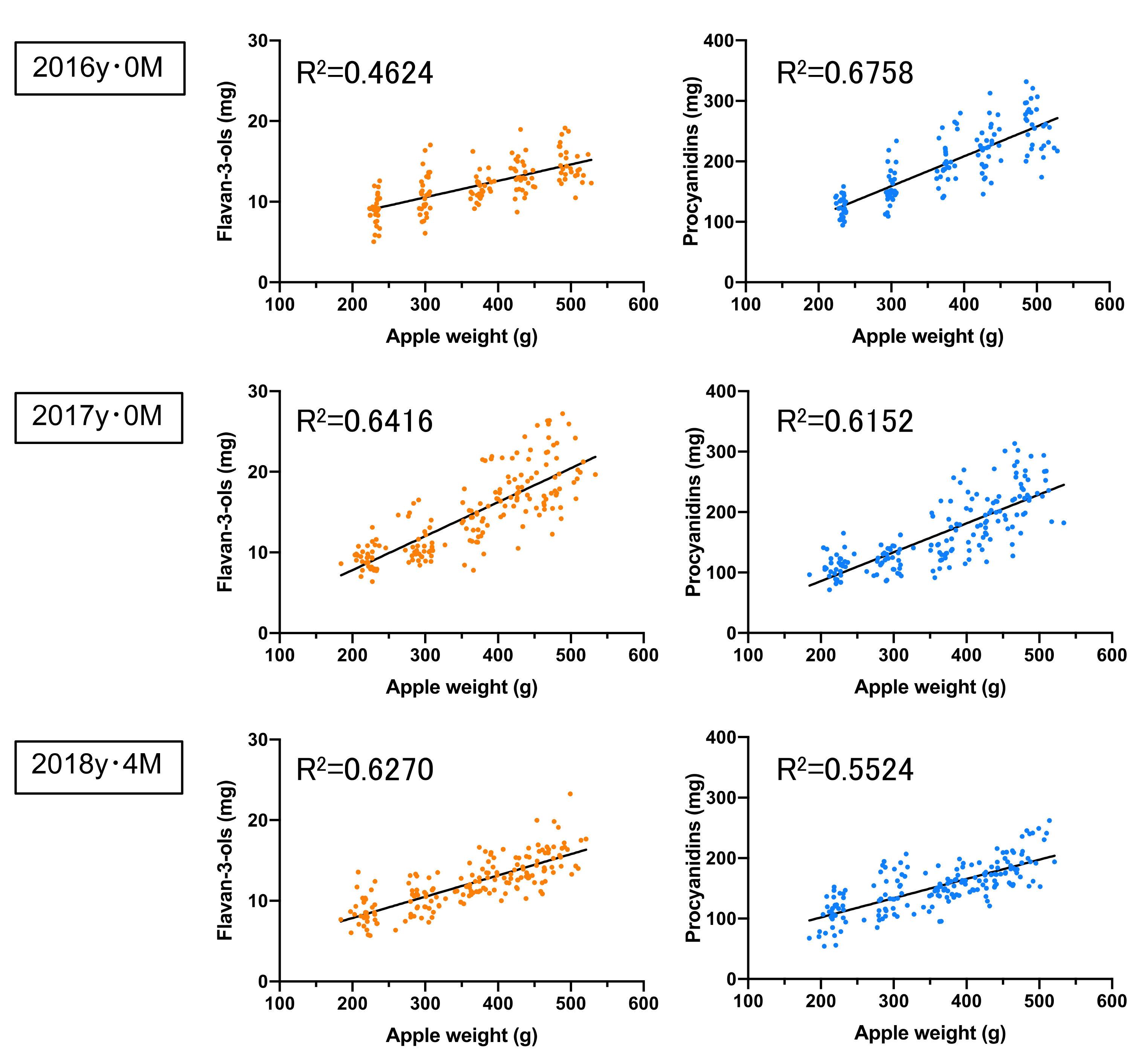
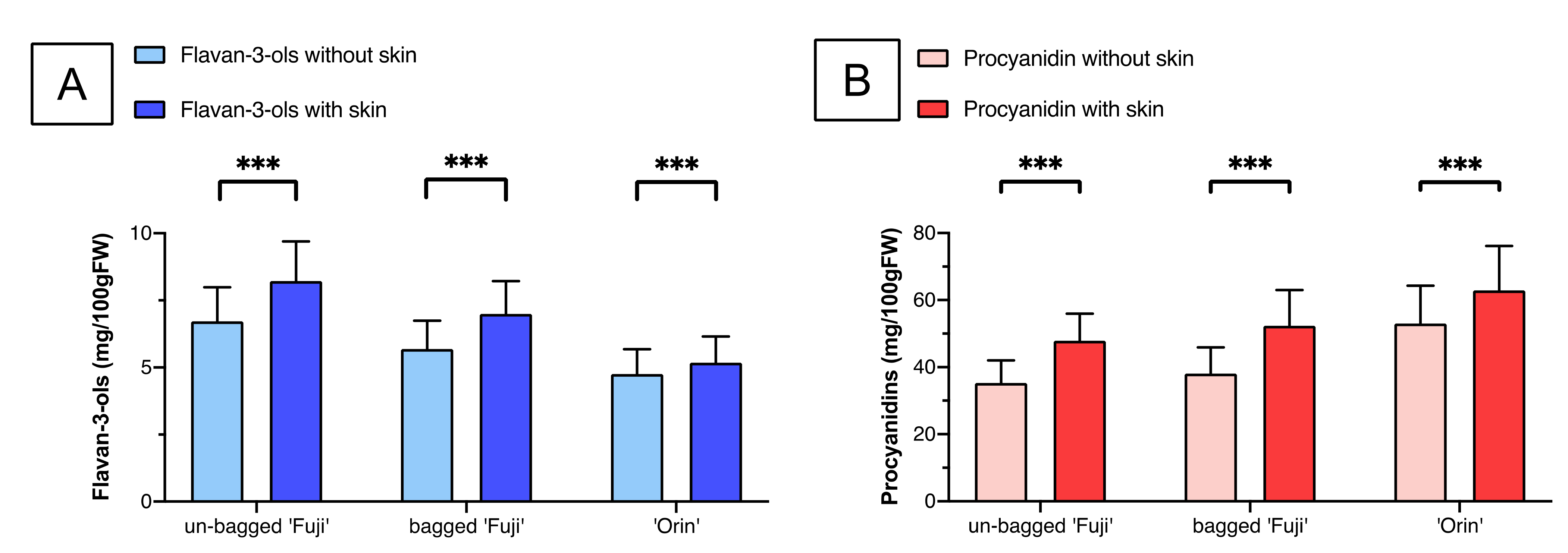
| Standard Compounds | Retention Time (min) | Calibration Range (µg/mL) | Calibration Formula | Regression Factor (R2) | RSD (%) | LOD/LOQ |
|---|---|---|---|---|---|---|
| (–)-Epicatechin | 4.56 | 4.5–45.0 | Y = 269140X + 34947 | 0.9989 | 3.97 | 0.007/0.021 |
| Procyanidin B2 | 6.12 | 10.55–105.5 | Y = 205281X + 419517 | 0.9987 | 2.91 | 0.010/0.030 |
| Seasons | Storage Periods (months) | n | Weight (g) | Soluble Solid (°Brix) | Flavan-3-ols (mg/100 g FW) | Procyanidins (mg/100 g FW) | P/F Ratio |
|---|---|---|---|---|---|---|---|
| 2016 | 0 | 196 | 357.9 ± 99.23 a | 13.78 ± 0.94 a | 5.42 ± 1.09 a | 34.70 ± 6.15 a | 6.40 |
| 2017 | 0 | 219 | 360.2 ± 87.42 a | 14.18 ± 0.68 b | 6.72 ± 1.26 b | 35.27 ± 6.73 a | 5.25 |
| 2018 | 0 | 194 | 339.8 ± 88.67 a | 14.11 ± 1.01 b | 4.33 ± 1.06 c | 37.77 ± 6.79 b | 8.72 |
| Seasons | Storage Periods (months) | n | Weight (g) | Soluble Solid (°Brix) | Flavan-3-ols (mg/100 g FW) | Procyanidins (mg/100 g FW) | P/F Ratio |
|---|---|---|---|---|---|---|---|
| 2016 | 0 | 195 | 345.9 ± 87.40 a | 13.49 ± 0.99 a | 5.84 ± 1.11 a | 39.18 ± 6.73 a | 6.71 |
| 4 | 199 | 351.7 ± 96.24 a | 12.97 ± 0.52 b | 5.03 ± 1.01 b | 41.63 ± 7.06 b | 8.28 | |
| 2017 | 0 | 235 | 355.0 ± 86.34 a | 13.39 ± 0.95 a | 5.69 ± 1.06 a | 38.13 ± 7.75 a | 6.71 |
| 4 | 235 | 349.3 ± 94.76 a | 12.87 ± 0.80 b | 6.06 ± 1.12 c | 35.74 ± 7.45 c | 5.86 | |
| 2018 | 4 | 237 | 336.7 ± 88.06 a | 13.38 ± 0.88 c | 4.70 ± 1.13 b | 37.76 ± 6.99 a | 8.03 |
| Seasons | Storage Periods (months) | n | Weight (g) | Soluble Solid (°Brix) | Flavan-3-ols (mg/100 g FW) | Procyanidins (mg/100 g FW) | P/F Ratio |
|---|---|---|---|---|---|---|---|
| 2016 | 0 | 148 | 368.7 ± 94.53 a | 14.12 ± 0.61 a | 3.92 ± 0.84 a | 61.79 ± 9.95 a | 15.76 |
| 2017 | 0 | 177 | 361.4 ± 94.42 a | 14.19 ± 0.80 a | 4.75 ± 0.93 b | 53.05 ± 11.25 b | 11.17 |
| 2018 | 4 | 179 | 356.8 ± 93.25 a | 14.20 ± 0.83 a | 4.04 ± 0.76 a | 51.10 ± 10.79 b | 12.65 |
Publisher’s Note: MDPI stays neutral with regard to jurisdictional claims in published maps and institutional affiliations. |
© 2021 by the authors. Licensee MDPI, Basel, Switzerland. This article is an open access article distributed under the terms and conditions of the Creative Commons Attribution (CC BY) license (http://creativecommons.org/licenses/by/4.0/).
Share and Cite
Shoji, T.; Obara, M.; Takahashi, T.; Masumoto, S.; Hirota, H.; Miura, T. The Differences in the Flavan-3-ol and Procyanidin Contents of the Japanese ‘Fuji’ and ‘Orin’ Apples Using a Rapid Quantitative High-Performance Liquid Chromatography Method: Estimation of the Japanese Intake of Flavan-3-ols and Procyanidins from Apple as Case Study. Foods 2021, 10, 274. https://doi.org/10.3390/foods10020274
Shoji T, Obara M, Takahashi T, Masumoto S, Hirota H, Miura T. The Differences in the Flavan-3-ol and Procyanidin Contents of the Japanese ‘Fuji’ and ‘Orin’ Apples Using a Rapid Quantitative High-Performance Liquid Chromatography Method: Estimation of the Japanese Intake of Flavan-3-ols and Procyanidins from Apple as Case Study. Foods. 2021; 10(2):274. https://doi.org/10.3390/foods10020274
Chicago/Turabian StyleShoji, Toshihiko, Mina Obara, Tadashi Takahashi, Saeko Masumoto, Hironaka Hirota, and Tomisato Miura. 2021. "The Differences in the Flavan-3-ol and Procyanidin Contents of the Japanese ‘Fuji’ and ‘Orin’ Apples Using a Rapid Quantitative High-Performance Liquid Chromatography Method: Estimation of the Japanese Intake of Flavan-3-ols and Procyanidins from Apple as Case Study" Foods 10, no. 2: 274. https://doi.org/10.3390/foods10020274
APA StyleShoji, T., Obara, M., Takahashi, T., Masumoto, S., Hirota, H., & Miura, T. (2021). The Differences in the Flavan-3-ol and Procyanidin Contents of the Japanese ‘Fuji’ and ‘Orin’ Apples Using a Rapid Quantitative High-Performance Liquid Chromatography Method: Estimation of the Japanese Intake of Flavan-3-ols and Procyanidins from Apple as Case Study. Foods, 10(2), 274. https://doi.org/10.3390/foods10020274






